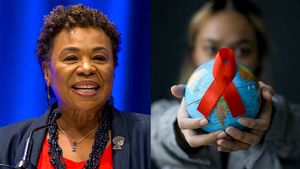
CONTACTStaffCAREER OPPORTUNITIESADVERTISE WITH USPRIVACY POLICYPRIVACY PREFERENCESTERMS OF USELEGAL NOTICE
© 2025 Pride Publishing Inc.
All Rights reserved
All Rights reserved
By continuing to use our site, you agree to our Private Policy and Terms of Use.
Rarely do you hear the words "I went to Easter Island on vacation." But if money and distance are no object, you can be the first couple you know to say iorana (that's "hello" in Rapa Nui -- both a language and a place) to the little island with the massive rock sculptures in the South Pacific, a perfect option for a rustic, remote honeymoon.
Located some 2,000 miles from Chile and 2,600 miles from Tahiti, Rapa Nui -- as Easter Island, its people, and their language and culture are known locally -- is considered the most remote inhabited location on the planet. However, you should dispel any notions of eating local tropical fruits under swaying palm trees. Easter Island's isolation and poor soil mean that most edible flora and fauna (with the exception of some homegrown avocado and guava and fresh-caught yellowfin tuna) are flown in from Chile, helping to make it a rather pricey destination. Deforestation has left the landscape somewhat barren -- historians theorize that ancient inhabitants cut down all the trees to transport those big stone heads.
But oh, those moai (pronounced MO-eye)! The primary draw of Easter Island is the human figure statues -- believed to be representations of ancestors positioned to watch over particular tribal communities -- so familiar from National Geographic photos. Erected between 1250 and 1500 and restored only in the last 50 years, the figures have an otherworldly pull that defies explanation.
The history of the island is equally mysterious and no less intriguing. European explorers "discovered" the place on Easter Sunday (hence its name) in 1722, but it is believed Polynesian migrants first inhabited the island 1,400 years earlier. The ideal base for learning the fascinating, harrowing tales of the creation of the heads, the island's famine, its civil war, and the surprisingly resilient island culture is the hotel Explora Rapa Nui, Posada de Mike Rapu.
The four-year-old, LEED-certified lodge offers the only luxury accommodations on the island; the alternatives include aging motels and camping, but what kind of same-sex honeymoon would that be? Explora's first-class services include private and group hikes, spelunking, snorkeling, scuba diving, horseback riding, and bike rides, all built around the rich stories of Rapa Nui. The food is worthy of any international destination, and you can return from a day of trekking to sip spicy, jam-like Carmenere, the delicious red wine of Chile.
Despite all the island has been through over the course of centuries, Rapa Nui has a live-and-let-live ethos makes the place surprisingly LGBT-friendly. A honeymoon there can be a perfect detour from the mainland on a grand South American journey to one of many established gay destinations in Argentina (like Buenos Aires or Iguacu Falls) or Brazil--or, even better, just fly through Santiago, Chile, and spend a week far from the crowds, being together on the ultimate eco-honeymoon.
The only airline that flies to Easter Island is Lan, which leaves daily from Santiago, Chile. Lan also flies nonstop to Santiago from New York, Los Angeles, and Miami, and on those runs, the business class service offers a touch of mid-century, Pan Am-style elegance. Lan.com
STAY
Explora Rapa Nui, Posada de Mike Rapu, runs on its own generator, which offers electricity (and limited Wi-Fi but, alas, no cell phone service) in the middle of an island that otherwise has electricity only in its lone town, Hanga Roa. Explora has two other eco-luxury adventure lodges in remote parts of South America -- glacier-gilded Patagonia and the Atacama Desert. Explora.com/explora-rapa-nui/posada-de-mike-rapu
PREPARE
Hawaii has The Brady Bunch and From Here to Eternity (or, for you young ones, 50 First Dates), but there's just one film that put Easter Island on Hollywood's radar: Rapa Nui. Don't recall it? The 1994 Kevin Costner-produced would-be blockbuster about a native people's struggle for survival failed miserably at the box office. But what Rapa Nui lacks in cinematic splendor and historical accuracy, it makes up for by having been the only major film ever shot on the island, employing plenty of locals and exposing them to a world beyond their 65 square miles and securing to celluloid images of the stunning moai and Easter Island's rugged coastline.
From our Sponsors
Most Popular
31 Period Films of Lesbians and Bi Women in Love That Will Take You Back
December 09 2024 1:00 PM
18 of the most batsh*t things N.C. Republican governor candidate Mark Robinson has said
October 30 2024 11:06 AM
True
After 20 years, and after tonight, Obama will no longer be the Democrats' top star
August 20 2024 12:28 PM
Trump ally Laura Loomer goes after Lindsey Graham: ‘We all know you’re gay’
September 13 2024 2:28 PM
Melania Trump cashed six-figure check to speak to gay Republicans at Mar-a-Lago
August 16 2024 5:57 PM
Latest Stories
Elton John: Brandi Carlile is 'probably the best vocalist in America'
January 08 2025 2:45 PM
Sheldon 'Turner' Freeman, gay D.C. librarian and activist, dead at 64
January 08 2025 1:46 PM
This long-term HIV survivor says testosterone therapy 'saved my life.'
January 08 2025 1:11 PM
Jesse Watters calls LGBTQ+ people 'nuts' for buying guns ahead of Trump's second term
January 08 2025 12:10 PM
Meet the gay man helping FEMA fight misinformation during natural disasters
January 08 2025 6:00 AM

















































































